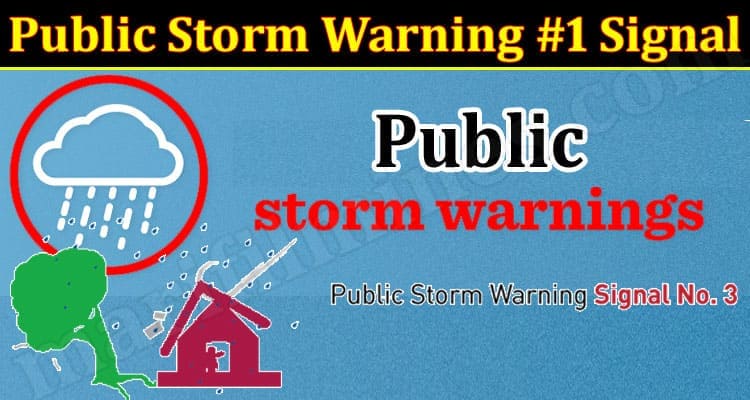The Philippine Public Storm Warning Signal
If you’ve ever heard of The Philippines’ public storm warning signals, you know that the government is very concerned about the weather. Whenever a storm approaches, you can expect an escalation in wind and rain. But how do you know when to get a warning signal? In this article, we’ll explain what each type of signal means. Then, we’ll go over the importance of knowing the exact location of a public storm warning signal and when to look out for it.
Public Storm Warning Signal #1
Table of Contents
A Public Storm Warning Signal (PSWS) is an alert system for impending weather disturbances. It is assigned to different areas based on various factors. As a storm approaches PAR, it is upgraded or downgraded depending on its potential impact. In general, PSWSs are only deemed severe when they threaten low-lying areas and structures. But this does not mean that people should evacuate their houses. It is advisable to remain indoors unless directed otherwise by local authorities.
The Public Storm Warning Signal #1 in the Philippines alerts people 36 hours in advance of a tropical cyclone’s impact. Wind speeds of up to 60 kmph are expected during this time. The PSWS also includes an impact timeline of 24 hours after the signal. Although a storm may not be felt in any given area, it is still important to prepare accordingly. If you’re not sure when a storm is coming, you should check weather reports and monitor weather forecasts every day.
Types of public storm warning signals
Public storm warning signals are issued when a tropical cyclone is predicted to be imminent. They are color-coded to indicate intensity, predicted areas of impact, and expected speed and direction. Public storm warning signals are also issued when heavy rain is expected within a few hours. The Philippines has a unified weather forecasting system developed by the Philippine Atmospheric, Geophysical, and Astronomical Services Administration.
The Public Storm Warning Signal (PSWS) system in the Philippines is divided into four types: PSWS-1, PSWS-2, PSWS-3, and PSWS-4. These different warning levels are issued based on the intensity of wind and rainfall. Generally, a PSWS-I signal should be issued if the forecasted storm intensity is greater than 90 kmph. Public storm warning signals may change from one level to the next based on the weather conditions.
- Also Read: A Closer Look at Two Hands Corn Dog
When are public storm warning signals used?
When are public storm warning signals used? These signals provide early warning systems for communities to help protect lives and property. Depending on the storm, they may cause no or moderate damage, but the earlier warning they receive, the better. During severe weather, public storm warning signals are an essential part of the emergency preparedness plan. If you live in an area that is frequently affected by severe weather, public storm warning signals can give you valuable time to prepare your home.
The first warning signal indicates an impending weather disturbance. Public storm warning signals are given out based on a variety of factors. As the disturbance moves through the PAR, it is upgraded or downgraded, indicating whether it is expected to cause light or moderate damage. If the storm is expected to reach the affected area, you may have to postpone outdoor activities for a while. However, you should still pay attention to the latest information and follow local and state authorities’ advice.
What each type of signal means
A Public Storm Warning Signal (PSWS) alerts the public to impending weather conditions. They are raised about 18 to 12 hours before the onset of a storm, and the number of warnings may be upgraded or downgraded based on the path of the disturbance. In most cases, the PSWS alert will notify the public about light wind damage to structures in open seas, and may occur within 24 hours.
When first put into effect, the Public Storm Warning Signal is a “first-stage” signal. It alerts the public to an impending storm and warns of a risk of damaging winds and heavy rain in that area. However, the warning is only valid for a specified period of time. Some houses built of light materials may not be adequately protected against the wind and rain, so they might remain partially or entirely unroofed.
Public Storm Warning Signal Conclusion
The Philippine public storm warning system consists of five levels, ranging from “primary” to “four,” and is based on tropical cyclone intensity, size, and forecast direction. If a tropical cyclone is expected to bring 30-60 kph winds within 36 hours, then a public storm warning signal #1 will be issued. A public storm warning signal is not a “red flag,” but rather a general announcement that people should stay home or take shelter.
If the storm is moving northwards and westwards, it will raise the Public Storm Warning Signal number. In the case of Odette, the forecasted intensity will rise to 120 kmph from 110 kmph. While a storm’s intensity will fluctuate, a PAGASA warning will keep the people informed if it is about to hit the Philippines. The forecast intensity will likely increase over the next few days, and a new Public Storm Warning Signal will be issued.
Find the Best Trending News on my UsGlobalWorld. We are Providing Professional High Quilty Services to Both Small and Large Businesses.




